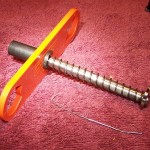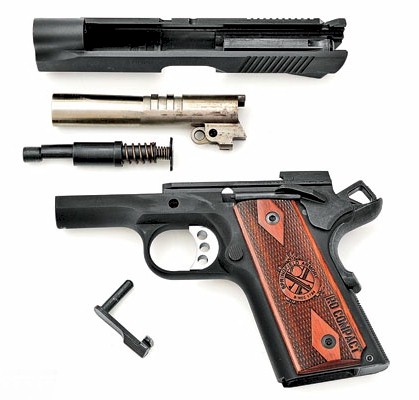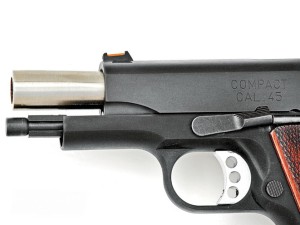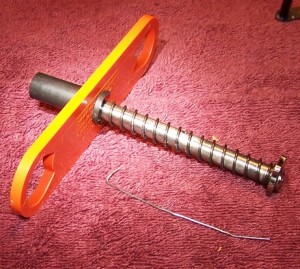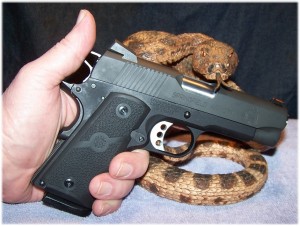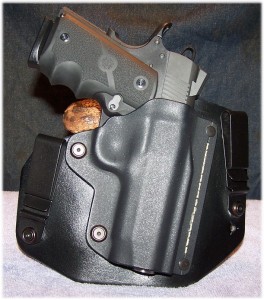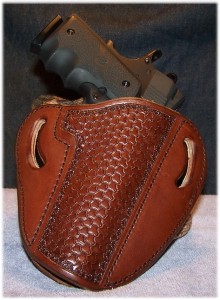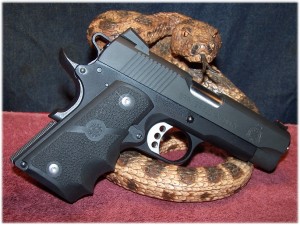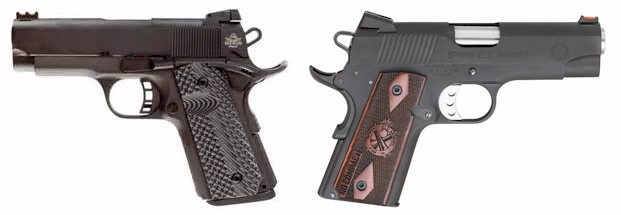 One last Hoorah! One last 1911-based pistol to be had and this one was a challenge; to decide which would be the last pistol in the stable, the Rock Island Compact Ultra .45 ACP or the Springfield Range Officer Compact in .45 ACP.
One last Hoorah! One last 1911-based pistol to be had and this one was a challenge; to decide which would be the last pistol in the stable, the Rock Island Compact Ultra .45 ACP or the Springfield Range Officer Compact in .45 ACP.
I had reviewed a lot of compact 1911-based pistols articles and videos in making my decision. I have owned a Compact 1911-based pistol in the past, the Colt Officer Model, and currently own a Rock Island 1st Generation CS Standard. I have carried the latter and it has been a good pistol; albeit, a new thumb safety is being installed because the original thumb safety was too soft for my liking. I turned over the pistol to a person who likened himself to a gun smith and installed a el-cheapo replacement thumb safety (incorrectly). The RIA CS Standard is now in the capable hands of a certified armorer who is installing a new Wilson Combat thumb safety and making things right. I posted a review of the CS Standard Compact at https://guntoters.com/blog/2015/08/27/rock-island-standard-compact-cs-45/.
Although I like the “Commander” length 1911 with its 4.25-inch barrel length, I had been thinking long and hard about adding another compact 1911-based pistol and there are plenty in the marketplace to like. However, the cost of many of those is prohibitive to my current financial situation. I should not be looking at another pistol at all, but the lure of a compact “Officer” model 1911-based pistol was just too much – and the search began.
FROM THE MANUFACTURER:
Rock Island Armory Compact Ultra .45 ACP (51497):
 “The Rock Ultra compact is built in traditional 70 series design and delivered with our precise engineering standards and first rate upgrades. This pistol is chambered in 45 ACP with a 3.50” button rifled barrel supported by a full length guide rod. Smooth angled, snag-free style allows for quick draw in fast need situations. Includes a low profile adjustable rear sight and high visibility fiber optic front sight. Also includes skeletonized hammer and trigger with adjustable over travel stop and ambidextrous safety, which comes standard in the Rock series. The Rock Ultra is finished with a tough Parkerzied matte coating and adds battle ready G10 tactical grips. True to all Rock Island 1911s, the Rock Ultra comes with a crisp factory 4- to 6-pound trigger to give you a great experience right out of the box.” – source: Armscor
“The Rock Ultra compact is built in traditional 70 series design and delivered with our precise engineering standards and first rate upgrades. This pistol is chambered in 45 ACP with a 3.50” button rifled barrel supported by a full length guide rod. Smooth angled, snag-free style allows for quick draw in fast need situations. Includes a low profile adjustable rear sight and high visibility fiber optic front sight. Also includes skeletonized hammer and trigger with adjustable over travel stop and ambidextrous safety, which comes standard in the Rock series. The Rock Ultra is finished with a tough Parkerzied matte coating and adds battle ready G10 tactical grips. True to all Rock Island 1911s, the Rock Ultra comes with a crisp factory 4- to 6-pound trigger to give you a great experience right out of the box.” – source: Armscor
Springfield Range Officer Compact .45 ACP (Pi9126lp):
 “If you want a competition grade 1911 that conceals better than a full-sized pistol, the Range Officer® Compact from Springfield Armory® offers finely tuned performance in a smaller package. The Range Officer® Compact brings the precision of a competition pistol in a small and straightforward configuration.
“If you want a competition grade 1911 that conceals better than a full-sized pistol, the Range Officer® Compact from Springfield Armory® offers finely tuned performance in a smaller package. The Range Officer® Compact brings the precision of a competition pistol in a small and straightforward configuration.
The Range Officer® Compact has the same quality forged national match frame and slide as the Trophy Match™ and TRP™ 1911s. It gets the same precision fit as these pistols, too. Add in the same match grade steel barrel, and you have a pistol that shoots well beyond its price tag. The Range Officer® Compact is topped with a fiber optic front sight and a low profile combat rear sight, so you have maximum visibility. The beavertail grip safety, extended lightweight trigger and flat mainspring housing allow the pistol to sit in your hand comfortably for long periods of time at the range. The single-sided thumb safety keeps things simple and functional. It all adds up to a pistol that will let you seriously compete in a variety of matches.
The Range Officer® Compact means that your favorite range pistol is now easier to carry. Are You Ready?” – source: Springfield Armory
With all of the manufacturer’s propaganda and sales pitching aside, it’s time to look at both of these pistols and why I chose one over the other.
Note: For the sake of simplicity, the Rock Island Armory Compact Ultra .45 ACP (51497) is simply referred to as the RIA CSU and the Springfield Range Officer Compact .45 ACP (Pi9126lp) is simply referred to as the SA ROC.
STYLING:
There is not really too much to say about the styling of a 1911-based pistol regardless of the manufacturer. The RIA CSU and SA ROC are both traditional styles with modern touches.
MODERN MANUFACTURING:
RIA CSU:
The RIA CSU has been manufactured using modern materials and technology to produce a forged slide and frame with a sprinkling of MIM parts that is not uncommon today. Rock Island Armory seems to make the 1911-based pistol work very nicely. I have, on occasion, had to tweak a few of them, but overall, they can be taken from box to range.
SA ROC:
The SA ROC list of features includes a forged carbon steel slide that is mated to a forged aluminum alloy frame. A “Match Grade” fully supported ramped bull barrel makes an impressive statement about the pistol. Of course, MIM parts are used where needed.
SIGHTING SYSTEM:
RIA CSU:
The RIA CSU uses a two dot NOVAK rear sight that is adjustable for windage and elevation. The front sight is a fiber optic type sight inset into a dovetail.
SA ROC:
The SA ROC incorporates a Fiber Optic Front sight (with exchangeable fiber colors) & Low-Profile Combat Rear with two-dots. The rear sight is not adjustable except through drifting.
FRAME AND SLIDE:
Of my favorite finishes on a pistol (or revolver) meant for concealed carry is stainless steel. Although there can be variances in how the steel was finished (brushed vs. polished), the finishes usually compliment each other. Even a contrasting black component (for example, Slide Lock and Thumb safety) looks nice. Even highly polished aluminum or chromed steel can add pizzazz to a brushed stainless steel gun.
However, since most manufacturers do not control what is being produced by part suppliers the best that you can hope for in a Parkerized or otherwise treated carbon steel, aluminum, and polymer-framed pistol is that all the parts match as closely as possible. However, there will always be some differences in finish and it boils down to what you will live with.
Gone, for the most part, are the days of high polished and color-matched blued steel revolvers and pistols.
RIA CSU:
The Parkerized frame and slide on the RIA CSU is well finished and well mated. When all parts are joined together, the unit weighs 2.35 pounds (unloaded). I have noticed some differences in coloration between major parts like the frame/ slide and controls with differences due to parts not being Parkerized in the same manner or time. Of course, I have also seen these differences in treatments on higher-priced 1911 pistols such as the Springfield and Remington. Sometimes, it seems that you have a “Frankenstein” of a pistol in your hand with all of the difference in component treatments.
The front strap incorporates vertical serration to assist in providing a good grip surface.
SA ROC:
The Forged Carbon Steel, Parkerized slide and Forged Aluminum Alloy, Black Hardcoat Anodized frame are well matched and mated. Usually, when a slide and frame of different materials and finishes are united, there is some difference in appearance. Springfield has done an excellent job of blending both fit and finish with the usual culprits of Slide Lock, Plunger Tube, Thumb Safety, and beaver-tail grip safety being slightly different. The Slide Stop and Plunger Tube are pretty well matched with a semi-glossy appearance. The thumb safety is a flat finish (Parkerized?) with the grip safety being somewhere in between the Slide Stop/Plunger Tube and Thumb Safety. The Mainspring Housing is matte finished checkered polymer. The hammer, another MIM component, is finished somewhere in between everything. Stark contrast to everything is provided by the aluminum trigger. Semi-glossy grip screws against the nice and thin, cross-cannon grip panels add another contrast. Overall, the appearance of the pistol somewhat takes away from the true quality of the pistol. As with the RIA CSU, the pistol has somewhat of a “Frankenstein” look to it.
One thing that is noticeable is that the base of the internal extractor protrudes slightly from the end of the slide and the difference in treatment in the extractor and the slide is evident. If you are used to a flush-fitting extractor, it might bother you. Not to worry your self about it; the extractor works just fine, thank you.The front strap is smooth and devoid of serrations or checkering.
SAFETIES:
If external safeties on a 1911-based pistol (or any pistol for that matter) bother you, just consider them as “fire-control system interlocking devices”. There, does that make you feel better, Bippy?
The original John Browning design did not incorporate a thumb safety. You can thank the U.S. Calvary for thumb safeties. Modern 1911-based pistols have external safeties; the thumb safety and the grip safety. Additional safeties are your trigger finger and your brain. And, depending on what “series” the 1911 pistol is, there may also be a hammer block safety in addition to the “safety notch” that has been built into the 1911 since early times. While not considered a position in which to carry the pistol, the “safety notch” theoretically serves the same purpose as the half-cock position on a single-action revolver – if the pistol is dropped on the hammer, the “safety notch” prevents the hammer from impacting the firing pin, and subsequently, the primer of a live cartridge. However, the hammer’s safety notch is subject to fail and the pistol should not be carried with the hammer in the “safety notch.” Safeties are there for a reason other than annoying you, because your brain and trigger finger are not always in agreement. Sometimes, brain flatulence occurs and you put your finger in the trigger when you’re not supposed to.
Aside from the single-action revolver, where the firing pin rests on an empty chamber, the modern 1911 is one of the safest handguns in the world. Somehow, the idea of putting a safety in the middle of a trigger has never really made sense to me. But, I digress.
RIA CSU:
 The RIA CSU utilizes the same safeties as a standard “Series 70” 1911-based pistol with the exception of the thumb safety being an ambidextrous thumb safety. I like the ambidextrous thumb safety because it allows me to operate the pistol easier when running the gun weak handed. The ambidextrous thumb safety has an extended lever that allows quick transitions from on-safe to off-safe and vice versa with either the strong hand or weak hand thumb. The thumb safety engages positively in both directions. Nothing really to rant about here as it performs its function well. With that said it is sometimes difficult to find a set of grips or grip panels for the RIA CSU or any RIA 1911 with an ambidextrous safety. If you decide to change out the grip panels that will fit the RIA CSU, you may have to special order them or otherwise perform some minor surgery on what panels you do get in order to clear the safety levers. However, the RIA CSU comes standard with VZ G10 grip panels that incorporate the necessary clearance to operate the safety lever. They look and work well.
The RIA CSU utilizes the same safeties as a standard “Series 70” 1911-based pistol with the exception of the thumb safety being an ambidextrous thumb safety. I like the ambidextrous thumb safety because it allows me to operate the pistol easier when running the gun weak handed. The ambidextrous thumb safety has an extended lever that allows quick transitions from on-safe to off-safe and vice versa with either the strong hand or weak hand thumb. The thumb safety engages positively in both directions. Nothing really to rant about here as it performs its function well. With that said it is sometimes difficult to find a set of grips or grip panels for the RIA CSU or any RIA 1911 with an ambidextrous safety. If you decide to change out the grip panels that will fit the RIA CSU, you may have to special order them or otherwise perform some minor surgery on what panels you do get in order to clear the safety levers. However, the RIA CSU comes standard with VZ G10 grip panels that incorporate the necessary clearance to operate the safety lever. They look and work well.
The ambidextrous thumb safety has an equally good platform for the thumb of either hand. Some ambidextrous safeties have one lever shorter than the other with the shorter being on the right side in most cases. The ambidextrous safety on the RIA CSU treats both thumbs as equals.
The RIA CSU is a “Series 70” pistol in that it does not incorporate the “Series 80” hammer block in its manufacturing. If you don’t understand the terms “Series 70” and “Series 80”, please refer to HISTORICAL NOTES at the end of the article for an explanation (courtesy of https://en.wikipedia.org/wiki/M1911_pistol).
The beaver-tail grip safety is standard fare and incorporates the memory bump for positive operation. It is fitted very nicely to the grip.
SA ROC:
As with the RIA CSU, the SA ROC follows the “70 Series” pistol and has no hammer block safety, but does incorporate the “Safety Notch” in the hammer. The thumb safety on the SA ROC is extended and is left-side only. While I prefer an ambidextrous safety, I have no issue with a 1911-based pistol that does not incorporate one. I have learned to run the safety with my weak hand (left). The thumb safety is extended and is very positive in operation from one mode to the other. When new, the thumb safety is stiff, but I would rather have one that way. Although stiff, it is stiff in both directions, which indicates that the safety was properly set up at the factory.
The thumb safety lever has a more than adequate thumb surface and is nicely curved to accommodate the thumb when it is moving the safety lever in either direction.
As with the RIA CSU, the SA ROC utilizes the beaver-tail grip safety as standard fare and incorporates the memory bump for positive operation. It is fitted very nicely to the grip. Nothing to brag about here as it works as intended.
The SA ROC incorporates a locking safety in the Main Spring Housing that requires a special key (provided) to engage and disengage. In short, don’t lose the special key. When in the locked position, the pistol’s action is completely inoperative. I have heard of some replacing the Springfield Main Spring Housing with a Main Spring Housing that does not incorporate the safety device. I would not recommend this in a pistol that is intended for carry due to liability issues should that pistol is ever used in a self-defense situation. Removing a factory safety is a no-no. I have every intention of leaving it as it is.
INTERNALS:
RIA CSU:
Internally, the RIA is well finished to include the frame-integral feed ramp. Barrel lock-up grooves are substantial and the barrel locks positively into place. When new, there is some roughness in the slide to frame but these will smooth out after use.
The 3.5-inch barrel is a tapered barrel (also known as a “Bull” barrel) and is commonly used in a lot of pistols these days thus removing the need for a barrel bushing. The slide, in fact, serves as the barrel bushing.
The feed ramp is integral to the frame as compared to the barrel integrated feed ramp on the SA ROC. In my 1st Generation RIA CS Standard, there are slight signs of abnormal wear that was possibly caused by a round contained in the magazine coming forward against the feed ramp. By the location, it would seem to be the second round in the magazine and was possibly a hollow-point round. Damage to a frame-integral feed ramp was common with aluminum-framed compact 1911’s in the past, and was usually due to hollow-point bullets damaging the soft aluminum of the frame. This was not expected in a pistol with a frame made of steel. However, the slight damage is below the point where a round stripped from the magazine would contact and does not interfere with feeding any ammunition. It is disconcerting, however.
SA ROC:
Internally, the SA ROC is finished well with nary a tool mark showing.
The 4.0-inch barrel incorporates the usual swing link, but also incorporates an integral feed ramp that is nicely finished. A barrel-integrated feed ramp, in my opinion is favorable over a frame-integrated feed ramp – especially when the frame is an aluminum alloy as is the SA ROC. Early lightweight “Commander” and “Officer” models of other manufacturer’s 1911-based pistols suffered feed ramp damage from aggressive hollow point ammunition against aluminum frames much to the consternation of their owners. Ruger opted for a titanium insert into the aluminum frame to counter any damage; whereas, Springfield utilizes the barrel-integrated feed ramp.
There are just some pistols that feel very smooth when feeding over others. The SA ROC is one of those pistols. Cycling the slide is like buttering bread with soft butter. I use Mil-Spec grease on all of my 1911-based pistols where meta-meets-metal. The SA ROC sings like a bird when you rack the slide and there are no signs of interruption when doing so.
MAGAZINES:
RIA CSU:
The RIA CSU comes with one 6-round flush fitting magazine. Any aftermarket 1911-based 7-round and above magazine will work in the RIA CSU. The ACT-MAG magazine works just fine, but I opt for Wilson Combat magazines for real carry. Mec-gar also manufactures well-made, flush-fit 6-round magazines.
SA ROC:
The SA ROC is shipped with two 6-round flush fitting magazines. The provided magazines would not be used by me, although some have reported no issues with them. Any aftermarket 1911-based 7-round and above magazine will work in the SA ROC. In fact, I would advise on using Wilson Combat 7-round magazines with bumper pads as they look good, they provide a 7+1 capacity, and with the shorter grip frame enhance concealment. Mec-gar also manufactures well-made, flush-fit 6-round magazines.
VISUAL IMPACT:
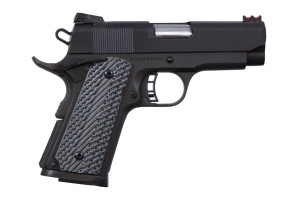 The visual impact of both pistols depends on the person viewing them. After all, they are both compact pistols of 1911-based design.
The visual impact of both pistols depends on the person viewing them. After all, they are both compact pistols of 1911-based design.
Gone is the billboard of the Rock Island Armory pistols and a nicely finished RIA logo is laser etched at the rear of the left side of the slide just before the hammer; it looks very nice there. The right side of the frame is devoid of markings and only the serial number and model number can be found on the frame. The VZ grip panels and TORX mounting screws adds to the visual impact of the pistol and provides a contrast to an otherwise mundane looking pistol.
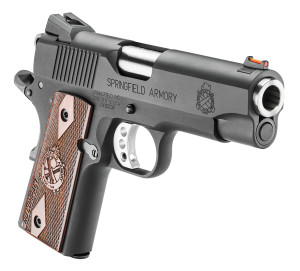 Springfield has opted to laser etch COMPACT.45 on the left side of the SA ROC slide and SPRINGFIELD ARMORY with the Springfield cross-cannon logo on the right side of the slide. The serial number and origin of manufacture (assembly?) is etched into the right side of the frame.
Springfield has opted to laser etch COMPACT.45 on the left side of the SA ROC slide and SPRINGFIELD ARMORY with the Springfield cross-cannon logo on the right side of the slide. The serial number and origin of manufacture (assembly?) is etched into the right side of the frame.
The Compact RO Double Diamond Thin Line Rosewood grip panels add a nice touch and contrast to the pistol. However, I intend to carry this pistol and the grip panels and Hogue Rubber Wraparound grip with finger grooves replaced the stock grip panels. The Hogue grips add some needed girth to the gripping area while providing me more control over the pistol. The Hogue grips are standard .025-inch thickness and really don’t take away from concealing the pistol; the short grip length does that. The SA ROC uses the shorter grip bushing and screws, but the grip mounting screws work well with the Hogue grip, and in fact, are slightly recessed into the grip. I like that.
Triggers differ between the two pistols. The RIA CSU is a black anodized aluminum, 3-hole skeletonized affair with an over-travel adjustment. The SA ROC trigger is a brushed aluminum, 3-hole skeletonized with over-travel adjustment that adds contrast to the Parkerized finish of the pistol. Both triggers work very well, thank you. I have to give the nod to the SA ROC in the trigger department; while both trigger work well, the SA ROC trigger works more cleanly and breaks crispier than the RIA CSU trigger. The trigger pull on the SA ROC is consistent at 5-pounds new with just a tad of grittiness, which will go away after working it a bit. Reset on both triggers is very close. While triggers are good on both pistols, the only difference is how much pull it takes to release the sear and both pistols do this well.
At the forefront of each pistol is of course the muzzle of the barrel. In this area, I give kudos to the RIA CSU with a target-crowned barrel that helps to mitigate damage to the effluent of the barrel. The muzzle is almost even with the slide, which affords more muzzle protection.
The muzzle of the SA ROC barrel is not crowned and the muzzle protrudes slightly ahead of the slide. While visually appealing, I would have preferred that the muzzle be even with the slide, or perhaps, not as protrusive.
Of course, the RIA CSU is shorter in length (7.13 inches) and longer in height (5.11 inches) than the SA ROC with its 7.6-inch length and 5-inch height due to the difference in barrel lengths (3.5-inches vs. 4.0 inches). Of the two pistols, the SA ROC seems to be the better balanced. It is far easier to hide the barrel than it is the butt, and since we are only talking 0.11 difference in height between the two pistols, the concealment factor is about the same with both (considering standard magazines in each pistol).
By comparison, the SA ROC is on par with the Springfield XDs 4.0 45 in length while adding a cartridge to the capacity. The SA ROC is ever-so-slightly heavier than the XDs 4.0 45 and also the Springfield XDs 4.0 9mm, which are two polymer-frame pistols. However, the platforms are totally different and doing a comparison might be a moot point over all.
DISASSEMBLY AND RE-ASSEMBLY:
When it comes down to it, both pistols are easy to disassemble (field strip), and it can be done without tools. It really comes down to “how” you want to disassemble and re-assemble them. However, the Full Length Guide Rod (FLGR) requires a helping hand when disassembling and assembling. I came up with a helping hand by modifying a standard barrel bushing wrench that makes short work of disassembling and assembling FLGRs. CAUTION! The FLGR is under extreme spring tension. The use of protective eye wear is highly recommended.RIA CSU:
Field stripping the RIA CSU can be done without using a paper clip to restrain the FLGR (Full Length Guide Rod) . The slide is removed in the normal fashion with the slide stop aligned with the correct notch in the slide. There will be a little tension felt when pulling the Slide Stop from the frame so you do need to hold the slide and frame together when doing so. After the Slide Stop is pulled free from the frame, simply allow the slide to go forward slightly, until any spring tension by the recoil spring is removed, and then remove the slide from the frame. At this point; however you will need the bent paper clip to remove the FLGR from the slide as an assembly because it cannot be removed without compressing the recoil spring and guide rod into an assembly.
With a bent paper clip at the ready, simply push the FLGR forward in the slide until you see the hole in the FLGR. Insert the bent paper clip into the hole to secure the assembly. You can then remove the FLGR assembly from the slide.
I have modified a barrel bushing wrench to disassemble the FLGR assembly for cleaning and lubrication. Essentially, a hole was drilled in the center of the barrel bushing wrench that fits the outer diameter of the FLGR bushing but allows the wrench to stop at the collar of the FLGR bushing. A simple press of the wrench allows me to remove or install the paper clip as needed to disassemble and assemble the FLGR assembly.
To re-assemble the pistol, the FLGR assembly is put into place in the slide. Then, I simply press forward on the FLGR assembly to remove the paper clip while maintaining pressure on rear of the FLGR. The, I slowly allow the FLGR to move rearward until it contacts the swing link mount. The LFGR has a tendency to ride up slightly on the Swing Link mount. I simply press the FLOGR forward slightly and hold in place against the barrel. Insert the slide into the frame until the FLGR is “captured” by the frame, which holds the FLGR in place. Located the swing link and install the Slide Lock enough to capture the barrel to the frame. Locate the disassembly/assembly notch in the slide and push the Slide Lock into place. (Note that the slide will be under spring tension at this point. I hold the frame and slide together as I push the Slide Lock into its place in the frame). Perform a function check and you are ready to go.
SA ROC:
Springfield Armory provides a FLGR plastic “keeper” to secure the FLGR when disassembling and re-assembling the slide and frame. The “keeper” is really needed when the pistol is new.
There are two methods to remove the slide from the frame and the following outline each method:
Disassembly Method #1:
The slide is first pushed to the rear to engage the Slide Stop with the Slide Stop Notch in the slide. The “keeper” is pushed into place on the Guide Rod and keeps the guide rod from returning into the slide. The slide is then removed in the normal fashion with the slide stop aligned with the correct notch in the slide, the Slide Stop removed from the frame, and the slide pulled forward off of the frame.
Once the slide is removed from the frame, the Guide Rod assembly, now a captive unit is removed from the slide to the rear of the slide. The barrel is then removed from the front of the slide
Disassembly Method #2:
Move the slide to line up the disassembly/assembly notch with the Slide Stop. Hold the Slide and Frame in this position and remove the Slide Stop (Note that the slide is under tremendous spring tension at this point). Slowly allow the Slide to move forward until no spring tension is felt. Then, remove the slide from the frame. The Guide Rod and Recoil Springs will rest against the Barrel Swing Link Housing.
The SA ROC uses a dual recoil spring arrangement. Once the slide is removed from the frame, the dual springs, FLGR, and FLGR bushing can be removed after making it a “unit” by pushing the FLGR to the front of the slide until you can press the plastic “keeper” in place on the guide rod. The FLGR “unit” is then removed from the rear of the slide. The barrel is removed from the front of the slide as usual.
Guide Rod Disassembly:
To totally clean the FLGR, it must be disassembled. I have modified a standard barrel bushing wrench to disassemble (and assemble) the FLGR on the Rock Island Armory MS and CS pistols and it also works with the FLGR assembly in the SA ROC, although the guide rod bushing on the SA ROC is just slightly smaller in the base that the RIA units. It still; however, works by compressing (while pointing the FLGR unit in a safe direction (I like using a rolled up towel in front of the unit just in case) the dual springs until the plastic “keeper” can be removed from the guide rod. Then, I slowly allow the bushing to go forward until no spring tension is felt and then remove the bushing from the assembly. The FLGR incorporates dual springs; one on the guide rod itself, and a second that is isolated from the first by an outer shell. The outer spring and shell can be removed to clean and lubricate the inner spring and guide rod. The inner spring and guide rod is a single unit. Once the FLGR components are cleaned and properly lubed, they are reassembled and then the FLGR assembly is once again compressed with the modified barrel bushing wrench, the “keeper’ put in place, and spring tension is released by removing the modified bushing wrench. Once again, the FLGR is a unit.Slide to Frame Assembly:
To assemble the slide to the frame, install the barrel as usual and insert the GLFR bushing into its normal position in the slide from the rear. Leave the “Keeper” in place on the FLGR unit. Also, ensure that the Guide Rod is positioned to fit properly against the barrel (the indention on the base of the Guide Rod, fits around the barrel).
Insert the slide into the frame. Locate the swing link and install the Slide Lock enough to capture the barrel to the frame.
Locate the disassembly/assembly notch in the slide and push the Slide Lock into place.
Press the slide to the rear and push the slide lock into the locking notch in the slide. This compresses the FLGR springs. Remove the “keeper” from the FLGR unit. Press the Slide rearward slightly and press the Slide Lock down to clear the Slide. Hold the slide and then slowly allow the slide to go forward into battery.
Perform a function check and you are ready to go.
THE FINAL CHOICE:
The quality of both pistols is excellent for their asking price range. I already own a 1st Generation RIA Compact (CS model) and would have liked to own an upgraded version. I could have upgraded the my 1st Generation RIA Compact with new grip panels, ambidextrous thumb safety, and sights to match the RIA CSU ( or better yet, night sights); however, I would have still ended up with a Rock Island Armory CS Standard with no possibility of recovering the cost of the upgrade should I decide to sell or trade-in the pistol at a later date. The SA ROC has one feature that I like – the 4-inch barrel, which puts it into the “Commander” class of 1911-based pistols (4.0-inch to 4.25-inch barrel). The narrow grip of the SA ROC is really a moot point, because the thin grip panels of the SA ROC can be easily (and inexpensively) swapped for a grip to my preference. The lack of an ambidextrous thumb safety is not a deal breaker. If I absolutely must have an ambidextrous thumb safety, I know where to find one and I have at my disposal a certified and competent armorer to install it.The VZ G10 grip panels on the RIA CSU are a nice upgrade to the RIA pistol, as is better sights than “Standard” or “tactical” RIA pistols.
On the face of it, it would seem that SA ROC magazine capacity of 6+1 would lose to the 7+1 capacity of the RIA CSU. However, I normally carry two 8-round Wilson Combat magazines for backup. After all, I carried the Springfield XDs .45 ACP with its round count of 5+1 with the standard magazine. I am not a round count fanatic, but 5 rounds is my lower limit in any handgun (with most long guns, actually). With that said, 7-round magazines work just fine in the SA ROC; they are simply not flush to the frame. The same can be said about the RIA CSU; they are; after all, both Office-size frames.
As you may have realized after all of this is that the SA ROC was, and is, my choice. Although the SA ROC is more expensive than the RIA CSU, the return on investment is greater as is the quality over the RIA CSU. As with any firearm, the initial value is lost as soon as you get the “paid in full” receipt on it. With the SA ROC, as compared to the RIA CSU, the monetary loss is a little less painful
HOW IT CARRIES:
Weighing in at 28.5 ounces (1.78 pounds) unloaded; the SA ROC is a joy to carry. The Hogue Wraparound Rubber Grips with Finger Grooves adds an additional 2.4 ounces of weight, which kicks the total unloaded weight up to 30.9 ounces (1.9 pounds) and we might as just well round things out to about 2 pounds. As a comparison, the Ruger SR1911CMD-A weighs in at 29.3 ounces (1.83 pounds) dry with standard grip panels and the RIA CSU weighs in at a whopping 37.6 ounces (2.35 pounds) unloaded with VZ G10 grip panels.With a barrel length of 4.0 inches, the SA ROC can be carried in anything that can house a “Commander” or “Government” length 1911-based pistol (for full muzzle protection) and any open-bottom holster like a Crossbreed Super Tuck Deluxe. The SA ROC feels right at home in my modified ACE-1 Gen 2 Holster by SHTF Gear that was intended for the Ruger SR1911CMD. As you may or may not know, I modified my ACE-1 Gen 2 Holster by removing the sweat shield; a feature that I do not like with a 1911-based pistol. The ACE-1 Gen 2 Holster houses any “Commander” length 1911- based pistols and also a shorter barrel length pistol like the RIA CSU with equal aplomb.
With a short grip area, the SA ROC pulls right into my side just where I like it and printing while bending over is greatly reduced over the longer grip length of “Commander” and “Government” pistols.
Of course, “Cocked and Locked” Condition 1 is the order of the day with a 1911-based pistol. I have full confidence in the SA ROC not to go “boom” if I accidently press the trigger with the thumb safety in the “on” position, unlike some pistols that incorporate a “safety” within the trigger. Just sayin’!
RANGE TIME:
It really does not take an immense quantity of ammunition to gauge the success, or lack of, in a firearm.
I had plenty of 230-grain FMJ ammunition on hand, but I wanted also to see how the SA ROC fared with 185-grain FMJ – to begin with. So, with 50-rounds of each, off to the range we go.
So, to what does one compare a lightweight, compact 1911-based pistol in .45 ACP to? Since I was used to shooting my Ruger SR1911CMD-A, which weighs only slightly more than the SA ROC and has a barrel length of only .25-inches more that the SA ROC, I had a good source for comparison. There is also the Springfield XDs 4.0 45, which is a smaller pistol (holding only 5-rounds in a polymer-framed, striker-fired pistol) and weighs only 23.5 ounces (about 1.5 pounds) unloaded, which is lighter than the SA ROC although the barrel is the same length. Between the SR1911CMD-A and the Springfield XDs 4.0 45, I felt that I had a good foundation for comparison.
I decided to use only the magazines that came with the SA ROC and loaded each with only five rounds – to break in the magazines. I had two standard silhouette targets; one to be used with 50-rounds of 230-grain (810fps) FMJ range loads from Georgia Arms, and one for 50-rounds of 185-grain FMJ (900fps). Both targets were set up at a distance of 10-yards. Rounds were to be shot using a modified Weaver and unsupported. I was testing for function more than grouping, but I would try to attempt the best group possible with the ammunition used.
Granted that the ammunition selected is not indicative of full-powered defensive loads, but the reason for using them was to simply check form and function. After all, I was breaking this thing in, alright!
First of all, I expected the Springfield to be “snappy” in recoil and muzzle flip to be, well, uplifting. I had already exchanged the thin grip panels with the Hogue Rubber Wraparound grip with finger groove to get a better purchase on the pistol and reduce the felt recoil a tad. There was not going to be any double-taps, running drills, or magazine dumps – just slow firing to see how well the SA ROC and I work out compatibility issues. As it turned out, there were none to speak of.
How bad does the SA ROC recoil? Not as much as I thought it would. Perhaps, it’s the design of the pistol, but the recoil is manageable and not all that much different from that of the Ruger SR1911CMD-A and Springfield XDs 4.0 45. That is easy for me to state, of course, because I have fired both of these pistols. I was pleasantly surprised with the SA ROC, and gladly so, because it has been accepted into the family and I have to live with my decision in accepting it. It’s really not a hard decision to live with.
One hundred rounds were chosen and one hundred rounds were shot without a failure. When I fire the gun, it just seems that it is a solid piece of work; it speaks of quality with every shot. What started out as a form and function check ended up being a fun session with my trying to hit different points on the target. Go for some head shots, go for a right shoulder shot, see if I could place a few rounds in that left kidney – that sort of thing. Where I aimed the SA ROC, and if I did my part, I could hit pretty darn close to what I was aiming at. That pleased me very much.
For my old eyes, the sights on the SA ROC are hard to pick up in the lighting at the indoor range. Outside in daylight, the sights were very clear and the red fiber optic sight up front really stood out. I will say that if I continue on with this gun and carry it for EDC, I would seriously consider outlaying the expense of putting a good set of Trijicon Night Sights on it.
All in all, it was a very fine day for me and the SA ROC.
SUMMARY:
Sometimes you get told in life, “So and so is not good for you!” or “So and so is too good for you!” I have also been told, “You didn’t deserve that!” Depending on the situation; however, that could be a good thing or bad thing that I didn’t deserve.The SA ROC is; essentially, a 1911 “Commander” slide on an “Officer’” frame. Fitting a “Commander” slide on an “Officer’” is not a new thing, by the way. It has been done before back “in the day.” Springfield Armory; however, has come to as close to the perfect compact 1911-based pistol as can be, in my opinion. There may be other combinations like the SA ROC, but financially speaking, they are probably well beyond my reach. I believe that the SA ROC is the middle ground that I have been looking for – and didn’t know it.
The 1911-based pistol has always been on my “A” list of handguns. Every now and then one comes around that is truly a performer and the SA ROC is one of those. Fortunately, the SA ROC is also chambered for the 9mm cartridge and possibly would appeal to those who like the 1911 platform and the 9mm cartridge (http://www.springfield-armory.com/products/1911-range-officer-compact-9mm/). Personally, I would look at the SA ROC in 9mm over the Springfield EMP in the same caliber due to the longer barrel length.
My personal SA ROC received the Hogue grip treatment, simply because they are my favorite grip. I need go and not show. However, I changed the grip screws from black, polished steel to stainless to compliment the aluminum trigger and “peek-a-boo” barrel.
SO, what did I gain (or lose) by going with the SA ROC?
- I gained 1/4-inch in barrel length.
- I gained less weight (can you actually gain a loss?).
- I broke even in round count, since 7-round magazines fit the SA ROC, although they are not flush fit. Remember that the SA ROC is an “Officer” model frame; Springfield opts to ship two, flush-fit 6-round magazines. The RIA CSU ships with one 7-round magazine with a bumper pad and is the same magazine that can be used in the ROC.
- I gained a much higher quality pistol. At a higher price, of course.
- I broke even with the sight system even though the rear sight on the CSU is adjustable. Who needs adjustable sights on a defensive pistol?
- I gained a suitcase full of stuff (holster, double-magazine pouch, cleaning brush, chamber flag, and a selection of front sight fiber rods).
- The SA ROC allows me to change grips without concerning myself with a special-cut, or having to modify grips, to make them work.
- I lost the ease of disassembly/reassembly with the SA ROC as compared to the RIA SCU, but it is still easier than disassembling/reassembling a Ruger MKIII 22/45. I can live with that.
So, what I have is like the manufacturer states, a “…competition grade 1911 that conceals better than a full-sized pistol, is a finely tuned performance in a smaller package, and in a straightforward configuration.”
THE FINAL WORD:
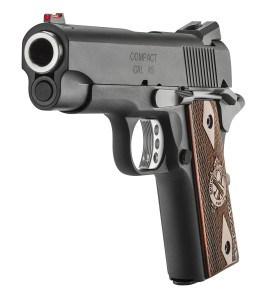 The Springfield Range Officer Compact can trace its lineage back to the RIA (Rock Island Arsenal and not Rock Island Armory) M15 General Officer’s Model that was issued to General Officers in the US Army and US Air Force from 1972 to 1981. Springfield Armory, as with Colt (with a nod to Remington), is synonymous with the 1911 and has a history of manufacturing fine weaponry back to the late 1700s. In fact, during WWI the Springfield Armory produced ≈25,000 M1911 pistols before all facilities were dedicated to production of M1903 rifles. Springfield is no stranger to the 1911-based pistol and that heritage continue today and, hopefully, well beyond tomorrow. In 1985, after the M9 was adopted by the U.S. Military, Springfield picked up manufacturing of 1911-based pistols for the civilian market and they have been enjoyed, and will continue to be enjoyed by many in the future.
The Springfield Range Officer Compact can trace its lineage back to the RIA (Rock Island Arsenal and not Rock Island Armory) M15 General Officer’s Model that was issued to General Officers in the US Army and US Air Force from 1972 to 1981. Springfield Armory, as with Colt (with a nod to Remington), is synonymous with the 1911 and has a history of manufacturing fine weaponry back to the late 1700s. In fact, during WWI the Springfield Armory produced ≈25,000 M1911 pistols before all facilities were dedicated to production of M1903 rifles. Springfield is no stranger to the 1911-based pistol and that heritage continue today and, hopefully, well beyond tomorrow. In 1985, after the M9 was adopted by the U.S. Military, Springfield picked up manufacturing of 1911-based pistols for the civilian market and they have been enjoyed, and will continue to be enjoyed by many in the future.
I was already leaning to the Springfield line of 1911-based pistols because of their quality and affordability over other manufactures. Had it not been for Sturm Ruger, Inc. introducing the fine SR1911, SR1911CMD, and SR1911CMD-A pistols, the ownership of a Springfield Armory 1911-based pistol would have been much sooner. Sometimes; however, things intervene with one’s plans for a purpose even though we may not understand why. For me, perhaps, the Springfield Range Officer compact was the reason for the intervention?
Bless the food and pass the ammunition!
HISTORICAL NOTES:
- Colt Government Mk. IV Series 70 (1970–1983): Introduced the accurized Split Barrel Bushing. The first 1000 prototypes in the serial number range 35800NM – 37025NM were marked BB on the barrel and the slide. Commander sized pistols retained the solid bushing.
- Colt Government Mk. IV Series 80 (1983–present): Introduced an internal firing pin safety and a new half-cock notch on the sear; pulling the trigger on these models while at half-cock will cause the hammer to drop. Models after 1988 returned to the solid barrel bushing due to concerns about breakages.
RESOURCES:
- The Springfield 1911 Range Officer Compact Model (.45ACP): http://www.springfield-armory.com/products/1911-range-officer-compact-45-acp/
- Springfield Range Officer Compact (Hickock45 review): https://www.youtube.com/watch?v=Ulv-EU_Y6Sw
- Hogue Wraparound Rubber Grips with Finger Grooves 1911 Colt .45 9mm #C45-000: http://www.amazon.com/Hogue-Wraparound-Rubber-Grooves-C45-000/dp/B00VQJFICY/ref=sr_1_1?ie=UTF8&qid=1451408878&sr=8-1&keywords=Hogue+Wraparound+Rubber+Grips+with+Finger+Grooves+1911+Colt+.45+9mm+%23C45-000
- Hogue Inc Colt Grip Hex head Screws Custom Stainless #45019: http://www.amazon.com/Hogue-Screws-Custom-Stainless-45019/dp/B0010XDK2Q/ref=sr_1_1?ie=UTF8&qid=1451408933&sr=8-1&keywords=Hogue+Inc+Colt+Grip+Hex+head+Screws+Custom+Stainless+%2345019
![]()



